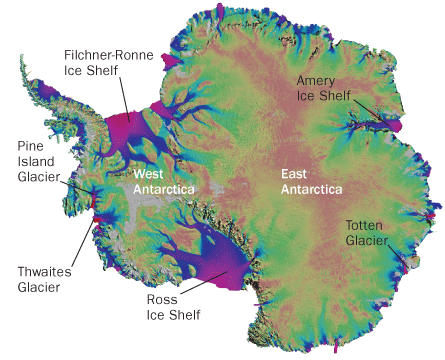A massive slab of floating ice that juts from Antarctica’s west coast could be in hot water soon. Warm ocean currents threaten to sneak up from below and torpedo the ice in coming decades, researchers report in the May 10 Nature.

The degradation of the historically stable Filchner-Ronne Ice Shelf would upset ice on land, triggering runaway melting over a vast region of the continent and accelerating global sea level rise.
“The loss of this ice shelf would be catastrophic,” says Ian Joughin, a glaciologist at the University of Washington. “We could be looking at tens of centimeters or even meters of sea level rise.” The finding is in stark contrast to recent research suggesting that sea level rise due to the melting of Greenland’s glaciers may fall short of worst-case scenarios (SN Online: 5/3/12).
“We need to start paying attention to this area of the West Antarctic Ice Sheet, which has so far been ignored,” says Laurence Padman, a physical oceanographer with Earth & Space Research in Corvallis, Ore.
Antarctica’s Filchner-Ronne Ice Shelf, located just east of the giant peninsula that extends toward South America, hasn’t caused much worry to date in terms of sea level rise. Anchored to the seafloor, the shelf extends outward over the Weddell Sea and covers an area the size of Sweden. The ice is hundreds of meters thick in places and shows signs of growth in recent years.
But climate change may soon reverse that trend, the new study suggests. Global air temperatures are projected to rise 4 degrees Celsius as the amount of carbon dioxide in the atmosphere increases over the next century. New simulations show the warmer air could thin and break up sea ice floating in Weddell Sea. Winds in the area would then transfer less energy to the ice and more energy directly into the ocean, churning up the water. In the researchers’ projected scenario, changing ocean currents push in warm waters that now circle Antarctica at a distance. By 2036 deep pulses of warm water reach up into shallow waters just offshore. By 2070 the heated currents completely displace the water that now fills the space between the ice shelf and the seafloor, raising temperatures by 2 degrees.
Heated in this way, the bottom of the shelf would disintegrate dramatically. Melting would jump roughly 20-fold from today’s 82 billion metric tons per year to 1.6 trillion metric tons per year by the end of the 21st century — or sooner.
“Having in mind that the presently observed CO2 emissions are larger than projected … the event can start even earlier,” says Hartmut Hellmer, a physical oceanographer at the Alfred Wegener Institute for Polar and Marine Research in Bremerhaven, Germany.
Warm water has already eaten away at other ice chunks in West Antarctica. Parts of the gigantic Pine Island Glacier lost four times as much ice in 2006 as in 1995. Air above the ice didn’t warm fast enough to explain this acceleration in melting, but in 2010 an autonomous submersible discovered a stream of warm water at the base of the glacier that could have done the job.
West of the Antarctic Peninsula, ocean-driven melting might already be widespread. Satellite observations show that several ice shelves on the Amundsen and Bellingshausen seas thinned between 2003 and 2008. Hotspots with the most melting were near seafloor troughs suitable for channeling warm waters blown in by the wind, researchers report in the April 26 Nature.
“People once thought that ice shelves change slowly over thousands of years,” says Hamish Pritchard, a glaciologist at the British Antarctic Survey in Cambridge. “We’re saying there’s a sensitivity to the oceans and to the climate that’s much greater than we previously realized.”
If the Filchner-Ronne Ice Shelf were to start shrinking, things could go from bad to worse very quickly. Radio waves beamed from an airplane show that the bedrock on which the ice is anchored tilts downward as it goes inland, researchers report online May 9 in Nature Geoscience. Retreating ice would thus pull back into ever-deeper waters, where more of the ice’s surface would be exposed and where higher pressures would speed melting.
“We believe this region is on the threshold of change,” says team member Martin Siegert, a glaciologist at the University of Edinburgh. “It needs some push to get over that [threshold], but we don’t believe that push has to be very hard to deliver a lot of deglaciation. ”
Siegert and his colleagues have also discovered that the shelf once shrank dramatically. A layer of sediments beneath ice farther inland must have been deposited during a time when the ice pulled back a couple hundred of kilometers, leaving the bedrock exposed to water.
If history repeats itself, the stakes would be high. With the thinning or disappearance of the shelf, ice that now covers West Antarctica would flow faster out toward the sea. An extraordinary amount of water could be dumped into the world’s oceans.
Back Story | ICE CONTINENT
 Eric Rignot, NASA, JPL-Caltech, UC Irvine, E. Rignot et al/Science 2011
Eric Rignot, NASA, JPL-Caltech, UC Irvine, E. Rignot et al/Science 2011







